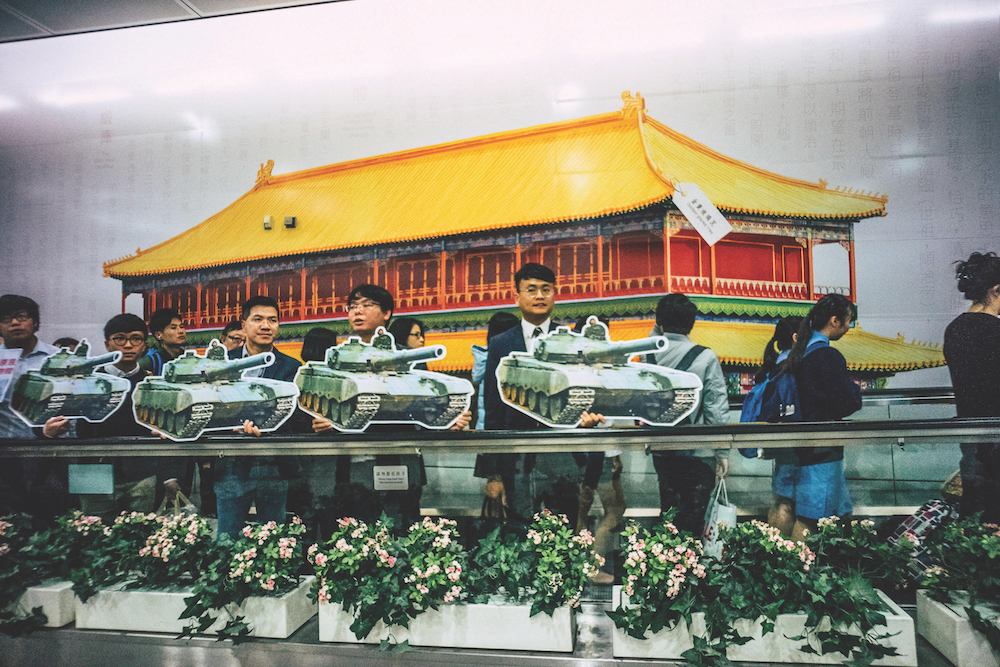Imperial by Design
by Denise Y. Ho

Pro-democracy protestors outside a mural of Beijing’s Palace Museum in Hong Kong’s Central MTR station. 2017. Photo: Yeung Kwan.
China’s Palace Museum has always been a symbol of political legitimacy, its art and artifacts a kind of currency. Making imperial treasures public to the new nation, it first opened its doors in the Forbidden City in 1925. But many of its finest pieces are no longer in Beijing — the Nationalist Party and its army took thousands of cases of art with them, first on retreat during World War II and finally into exile on Taiwan, where the collection is hosted in a second Palace Museum in Taipei. When the People’s Liberation Army entered Beijing in 1949, its generals had maps and strict orders to safeguard the Forbidden City. Even in the Mao era, the Communists still valued cultural artifacts, building “socialist museums” to make antiquity accessible to the masses, and before the tumultuous Cultural Revolution even came to an end, the Palace Museum was secretly prepared for reopening in advance of President Nixon’s famed 1972 visit to China.
Now there will be a third Palace Museum. Last December, officials in Hong Kong announced a Hong Kong Palace Museum for the West Kowloon Cultural District, a major development project that will also be the home of the contemporary art museum M+. However, the plan has ignited political tensions and sparked public protests. In the former British colony, which shifted to mainland Chinese rule in 1997, the opposition reflects the question of independence from Beijing, a concern that culminated in unprecedented street occupations during the Umbrella Movement of 2014. Protestors see the Hong Kong Palace Museum as yet another encroachment on the city’s autonomy.
Supporters of the Hong Kong Palace Museum, including Carrie Lam, the city’s new chief executive, assert that it will be a “Hong Kong museum”: Beijing’s Palace Museum will lend only objects and expertise, and it will be funded by one of the city’s main charities, the Hong Kong Jockey Club. But the museum’s detractors accuse Lam of using the Hong Kong Palace Museum (openly billed as a gift from Beijing to celebrate the 20th anniversary of the handover) for political favor in advance of her election last March. They claim that the planning process lacked transparency, and argue that the ex post facto “public consultation” was a rubber stamp for a project whose design and very existence were already a given.
Behind the Palace Museum controversy is anxiety about Chinese control and disagreement over the nature of Hong Kong identity. Advocates of “localism” call for the preservation of a Hong Kong culture, which may be Chinese in heritage but distinct from “Chinese” as defined by the Communist Party. In this view, the Hong Kong Palace Museum is an exercise in soft power, one in which the People’s Republic of China is the steward of history. Indeed, national pride is part of the work of Beijing’s Palace Museum. A few years ago, I attended an impressive lecture in Hong Kong by its director, Shan Jixiang, who underscored the scale of the Palace Museum’s collections, its state-of-the-art conservation work, and the millions of visitors that make it the best attended museum in the world. If a century ago China was the “sick man of Asia,” its cultural treasures removed to Western capitals, now the world comes to China, the Forbidden City the preeminent symbol of its history and power.
The debate over the Palace Museum has orbited around the city’s increasingly fractious local politics. But what should a “Hong Kong museum” be, anyway? A review of the project written for Hong Kong’s governing body states that “Hong Kong is an international cultural metropolis with a distinct identity grounded in Chinese traditions,” and describes “a Hong Kong museum featuring the history of the Forbidden City and traditional culture represented by the extensive imperial collections.” At stake here is not only how “Chinese” Hong Kong identity is, but also what role Beijing will play in defining it. How will exhibitions be decided upon? What does it mean to have “advice and assistance where necessary” from the Beijing Palace Museum? And what role will be played by Chinese curators who sit on the Hong Kong museum’s board? The openness of bureaucratic procedure is certainly a barometer of the Hong Kong Palace Museum’s transparency. But what will ultimately matter is not the vessel but its contents, not the blueprints for the museum but the narratives of its exhibitions. Whose version of Chinese history will be on display?
Museums in China have long abandoned the ideological rhetoric of the Mao era, and today pride themselves on being on the cutting edge of museology worldwide. Their curators are academics and intellectuals, often with western education and experience. Yet President Xi Jinping has repeatedly borrowed from China’s historical tradition, both in the craft of domestic slogans and the formation of foreign policy; under his regime, the space for doing history continues to tighten. Self-censorship remains a powerful force in Hong Kong, where politically sensitive exhibits are privately sponsored, and where the city’s main historical museum ends its story in 1997. Thus any hint that Hong Kong might cede control over its historical narrative is bound to be fraught. What the Hong Kong Palace Museum’s objectors fear is accepting a vessel with unknown contents, a gift that may turn out to be a Trojan horse.